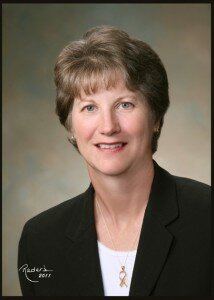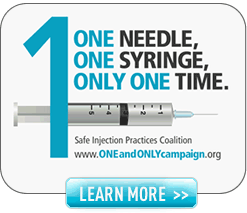A charmed life.
That’s what I had in the fall of 2000. I had a loving husband, three healthy sons, a rewarding career, and a comfortable home in the Midwest. But the unsafe injections I received in my doctor’s office changed my life in a profound and permanent way.
My husband and I were shocked when I was diagnosed with breast cancer. I was a healthy 45 year old with no risk factors. Immediately we turned to the only oncologist in our town. Tom was well acquainted with him since he had referred to him many of his family practice patients. We were confident I would receive quality care.
We were assured that this breast cancer diagnosis was only a “little bump in the road of life” and I would resume my charmed life after six months of chemotherapy in his private clinic.
The six months of chemotherapy passed uneventfully and although I continued to experience fatigue, we were assured that I would soon be able to rejoin all the activities of family life. But when I felt a lump grow over the mastectomy incision site, we were terror stricken. The biopsy came back positive, and my doctor had tears in his eyes when he informed us that I was now facing stage III cancer.
We consulted with the Mayo Clinic and the University of Nebraska Medical Center. When we decided I would have high dose chemotherapy and stem cell rescue, I had to undergo extensive testing in preparation. We were shocked when results came back positive – this time for Hepatitis C (HCV). Once again I had no risk factors, no explanation for how I had contracted this disease associated with risky behavior.
Tom and I were so stigmatized by this diagnosis that we told no one else about it. We had one life threatening disease to face – cancer – and we decided that we would put Hepatitis C in the back of our minds and devote all our energy to surviving the stem cell rescue and beating the cancer.
But being an astute clinician, Tom could not let the puzzle go unsolved. After the successful stem cell rescue, he could see that I would be alright and he let his thoughts turn toward solving the conundrum. Finally, he shared his puzzlement with Jean, his office nurse of 21 years.
Jean was dealing with her own set of challenges. Her oldest son had been diagnosed with cancer and had gone through chemotherapy at the same time that I had in our local clinic. Immediately, she shared Tom’s concern and offered this observation: “You know, Doctor, when I sat with my son during chemotherapy, I saw some nursing procedures that I did not think were safe. When I mentioned it to the doctor, he assured me everything was done properly. But I’m not sure it was.”
What happened next was a set of unbelievable events, a true story that is stranger than fiction. Ultimately after an investigation by the Nebraska Health and Human Services and the CDC, it was determined that 99 Nebraskans contracted Hepatitis C through unsafe injections during chemotherapy. To learn all the shocking details, I recommend you read A Never Event: Exposing the Largest Outbreak of Hepatitis C in American Healthcare History (History Examined, 2010 www.ANeverEvent.com), a book I wrote with attorney Travis Bennington.
The transmission of Hepatitis C happened when a nurse reused syringes to access a large saline bag numerous times for port flushes. A patient with known HCV had a blood draw and the nurse used the same syringe to access the saline bag, contaminating the bag with HCV. Subsequently, patients who were given flushes with saline from the bag were exposed to HCV. Through facts uncovered in the investigation we know that these unsafe injections went on for at least 15 months, exposing more than 600 people to deadly diseases.
The outbreak had huge repercussions for the patients, their families, the medical system and the community at large. People suffered physically, emotionally, socially, and financially. At least six people died from HCV, not the cancer that brought them to the doctor in the first place (Mark Mailliard, MD, personal communication, February 17, 2010). The resulting 89 lawsuits lasted for years and the town was divided between supporters of the victims and supporters of the medical community. I would venture to say that many in the community are still struggling to recover from the disaster, now thirteen years later. I know that I am.
We used my malpractice award to provide the seed money for “Hepatitis Outbreaks’ National Organization for Reform” (HONOReform). HONOReform is the only national advocacy organization dedicated to protecting patients through safeguarding the medical injection process. Our vision is a nation in which the medical injection process is safe from manufacture to disposal of used product.
Do I still have a charmed life? Yes, in many ways I still do. I am honored to spend my days educating and advocating for safe injections for all Americans. I do this because I don’t want what happened to me to happen to anyone else.



Congratulations – I love the blog. Excellent work you are doing.
Hello Evelyn,
I like your new blog. I so admire you and HONOReform for using the money from the lawsuit to improve our medical system and save lives. Just imagine what might happen if all Americans worked to improve some small aspect of our system.
P.S. Who is the doctor depicted on this site?
I have followed Evelyn McKnight’s efforts for years. Evelyn’s tenacity bringing iatrogenically acquired HCV to the attention of politicians and the medical industry speaks to her sense of justice. Although I was unsuccessful at gaining compensation from my local urologist’s insurance company for acquiring genotype 1a HCV from his May 1994 cystourethroscopy, this doctor ultimately left the California Central Coast for Florida to evade the wrongful death lawsuit that my wife will bring upon my demise. His attorney told me that his nurse, who didn’t properly clean the urologist’s endoscope, died from her cigarette habit. The SB County Public Health Chief refused to investigate and ultimately had me thrown off the California HCV Task Force for asking him in a public forum why wouldn’t he examine the urologist’s patient files to determine who was patient zero. Evelyn McKnight’s bringing iatrogenic HCV to the attention of legislators may someday bring about criminal penalties for medical personnel that infect patients or participate in HCV cover-ups. Evelyn McKnight’s efforts has taken iatrogenic HCV from the secrecy of MMR Boards and pushed these horrific occurrences into the public light.
Thank you Evelyn for all your efforts,
Walt Taylor-Santa Maria, CA
Walt, you make a good point. An unsafe injection is one way that disease can be spread through health care, but there are other ways such as improperly sterilized equipment, disregard of standard precautions, etc. Thanks for bringing this to light! evelyn
Great work, and I know of someone who had this horrible tragic event occur to them..
thank you, Eric. our best wishes to your friend.
Congratulations! Good way to educate and engage the public in your advocacy for reform.